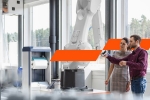Value in motion

AI, climate change and geopolitical shifts are reconfiguring the global economy. We’ve mapped where value is moving over the next decade, so you can build a future-ready business to capture it.
Your growth plan just got interesting
AI, climate change and shifting geopolitics are changing the way we live and work.
Creating new customer needs and preferences. Forging new markets. Enabling new business models. Attracting new competitors. And blurring the boundaries of sectors and industries.
It’s time to look for growth in new places.
It’s time to explore new domains of growth—markets where companies work across sector boundaries to meet fundamental human needs. Like how we feed and care for ourselves, move, make and build things, and how we fuel and power it all.
Scroll on to understand how these domains will form and grow. And discover how to seize your share of the value in motion.
Value in Motion
To see which domains hold opportunity for you, click on the graphic below.
Future scenarios: how megatrends are reshaping our world
Three scenarios for 2035
To envision 2035 as realistically and usefully as possible, we focused on a trio of plausible global scenarios: three divergent tomorrows.
Each ‘tomorrow’ varies from a baseline scenario, which assumes current trajectories persist. And each tomorrow contains specific assumptions about AI deployment and climate response that inform our economic modelling.
Want to learn more about the various future scenarios? Read the article ‘Envisioning Three Tomorrows’.
Explore the domains of growth
Select from the nine domains below to learn how they are forming, the size of the opportunity and how to seize the value in motion.
How we Make
The Make domain is changing the face of manufacturing. Digitisation, automation and advanced technologies like AI, IoT and 3D printing are at the core of the transformation. Companies are reimagining production—integrating capabilities across sectors to build an expansive, tech-driven ecosystem.
They're boosting efficiency, sustainability and resilience.
They're adapting to climate changes, shifting trade dynamics and honing specialised skills.
And it's all driven by collaboration between manufacturers, AI firms, robotics experts and cybersecurity providers. By 2035, the Make domain could add over $34 trillion to global GDP.
Opportunity by region

How we Build
The Build domain is transforming. Driven by climate change, urbanisation and AI advancements, industries are coming together in new ways to revolutionise how we design, construct and manage structures and cities. Engineering, construction, finance and real estate companies are forging partnerships to create spaces that are more resilient, efficient and tech-savvy. Collaboration across sectors is opening up new opportunities—from venture capital investments in property tech and energy efficiency to integrating smart home solutions and sustainable infrastructure. As businesses rework their models, the Build domain is set to add $13.76 trillion to global GDP by 2035.
Opportunity by region

How we Feed
The formation of the Feed domain represents a pivotal shift in the global agri-food system, one driven by the need to nourish a growing population while enhancing resilience and sustainability. Climate challenges, scarce resources and food waste are pushing businesses to rethink food production, processing and consumption. With agriculture, technology, logistics and finance sectors joining forces, firms are embedding AI, mechanisation and eco-friendly practices to increase efficiency and cut environmental impact. As these changes gain momentum, the Feed domain could add $9.88 trillion to global GDP by 2035. AI advancements and climate adaptation efforts are steering this growth.
Opportunity by region

How we Care
The Care domain is in the midst of a major transformation—healthcare organisations are adopting AI, digital platforms and cross-sector collaboration to deliver more effective, affordable and personalised care. With ageing populations, rising chronic disease costs and tech advancements as catalysts, pharmaceutical, medtech and digital health firms are weaving predictive analytics, telemedicine and wearable devices into their approach to enhance patient outcomes. This move toward holistic healthcare solutions is set to blur traditional industry lines, with the Care domain projected to contribute $9.31 trillion to global GDP by 2035. AI-led innovation and climate-related healthcare challenges are critical forces driving this change.
Opportunity by region

How we Move
The Move domain is transforming as mobility leaders adopt clean tech, AI, and digital solutions to boost transportation's efficiency, sustainability, and affordability. Traditional sectors—like automotive, logistics, rail, air and sea—are changing through cross-sector collaboration. Emerging tech players are integrating electrification, autonomous vehicles, and circular business models. This evolving ecosystem, propelled by climate needs and tech disruption, is poised to add $5.86 trillion to global GDP by 2035. Its path is being forged by AI advancements, changing mobility preferences and sustainability-driven innovation.
Opportunity by region

How we Fuel and Power
The Fuel and Power domain is in the midst of transformation as the global energy sector responds to climate imperatives, technological progress and increasing demand. Traditional fossil fuel chains are integrating zero-carbon electricity, alternative fuels and AI-driven efficiency solutions—ensuring energy access while backing industrial growth. As transportation, homes and industries shift towards electrification and low-carbon options, collaboration between established and new players is driving innovations in storage, transmission and sustainability. Guided by AI and climate action, the Fuel and Power domain is expected to add $6.19 trillion to global GDP by 2035.
Opportunity by region

How we Govern and Serve
The Govern and Serve domain is evolving as governments work with industries to tackle shifting global demands sparked by climate change, AI and demographic shifts. Public institutions are key players in fostering innovation—from supporting resilient infrastructure and smart cities to nurturing sustainable materials and AI-powered healthcare. As sectors reshape, governments are crafting policy, advancing public-private partnerships and using technology to boost citizens’ well-being and economic prosperity. By 2035, this domain could add $17.42 trillion to global GDP, spurred by AI-driven efficiencies, climate adaptation and changing regulatory frameworks.
Opportunity by region

How we Fund and Insure
The Fund and Insure domain is changing as industries realign around human needs, opening new doors for financial services and capital allocation. With businesses crossing sector boundaries, financial firms need to adapt—creating new risk models, valuation approaches and investment strategies. Partnerships between traditional financial players and non-financial firms are transforming capital deployment, management and insurance, fostering efficient growth models. As climate change and AI disrupt the financial landscape, the Fund and Insure domain is set to significantly boost global GDP by 2035—offering fresh routes for value creation in our evolving economy.
Opportunity by region

How we Connect and Compute
The Connect and Compute domain is a driving force for cross-sector collaboration, fueled by tech disruption and AI-enabled innovation. As industries embed computing power and connectivity into their models, companies from tech, telecom, energy, manufacturing, finance and government are joining forces to create seamless solutions. From smart infrastructure and advanced data centres to AI-powered services and semiconductor breakthroughs, partnerships are unlocking new sources of value. With climate and technological megatrends shaping its trajectory, the Connect and Compute domain is set to play a pivotal role in the global economy, with its contribution projected to fluctuate based on evolving industry needs and advancements between now and 2035.
Opportunity by region

Explore further
To further explore our value in motion data, and understand more about what it means for your sector and different territories worldwide, visit our global research site.

Contact us








